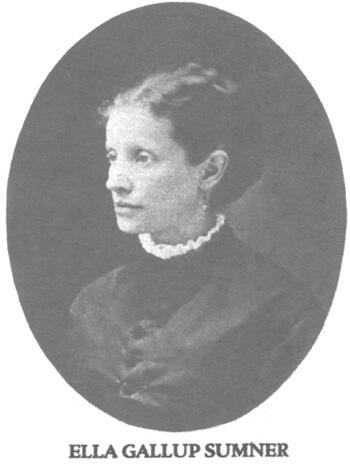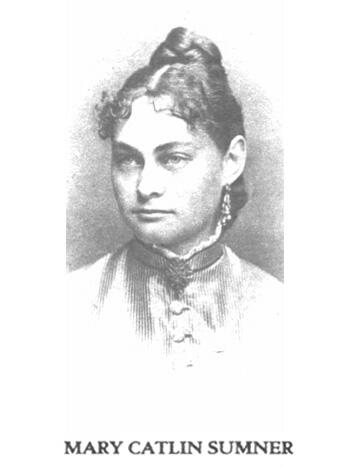by Hans DePold, town historian
(Published in the Bolton Community News, April 2006)
The name of Sumner is well known not only in Bolton, but also in the history of Connecticut and the United States. The Sumner family includes long lines of patriots, diplomats and statesmen. Members of the family have been prominent in all the professions, especially in business and in finance. On December 25, 1977, the Hartford Courant Magazine featured a story about the 50th anniversary of the largest bequest for paintings ever made to the Wadsworth Atheneum. The 1927 donation of nearly $2 million was given in the names of the wives of the two Bolton brothers, Francis and George Sumner. The Ella Gallup Sumner and Mary Catlin Sumner Collection remains the most extensive collection of paintings at the Wadsworth Atheneum today.
The Connecticut family of Sumners traces back to William Sumner, born at Bicester in Oxfordshire, England in 1605. On November 22, 1625, he married Mary West. He settled in Dorchester, Massachusetts, in 1636. He was made a freeman of the Colony on May 17, 1637, became a selectman of Dorchester in the same year, and acted in that capacity for 20 years. He was deputy to the General Court for eight years. Their son, William (2) Sumner, was born at Bicester in Oxfordshire, England, and came to America with his parents in 1636. He settled in Dorchester where he married Elisabeth, daughter of Augustine Clement, of Dorchester. He was a mariner, and died in February 1675.
Their son, Clement Sumner, the ninth child in a family of 10, was born at Boston, Massachusetts on September 6, 1671. On May 18, 1698, he married Margaret Harris. Their son, Dr. William (3) Sumner, the first child in a family of seven, was born March 18, 1699. On October 11, 1721, he married Hannah, daughter of Thomas Hunt, of Lebanon, Connecticut. He was a physician and practiced his profession in Hebron. He died March 4, 1778. Their son, Ruben Sumner, the third of nine children, was born in Hebron on May 29, 1727. On March 6, 1754, he married Elisabeth Mack, of Hebron. He died April 2, 1807.
Their son, Rev. Henry Peterson Sumner, was born June 10, 1773, the ninth child in a family of 11 children. On September 11, 1798, Mr. Sumner married Mary Goslee, daughter of Timothy Goslee, of Glastonbury. Rev. Sumner was a clergyman of the Methodist church, and he traveled his circuit on horseback, fulfilling the many demands of his calling in a time when roads were little more than Native American trails, with distances between settlements of 15 to 20 miles. He held religious services very often in the houses of church members. He was a prominent member of the church conference. Rev. Sumner died January 18, 1838, and his widow passed away at the Bolton homestead on August 9, 1875.
Their son, John Wesley Sumner, was the eighth of 11 children. He was born September 16, 1812. He was the first Sumner to reside at the Minister's Farm (the recently acquired Rose Farm) in Bolton, and he was a prominent Democrat and represented Bolton in the General Assembly in 1877 and 1878. On November 23, 1836, he married Mary, daughter of George Gleason, of Glastonbury.
Their son, George Gleason Sumner, was born January 14, 1842. Mary Ella was born April 24, 1848. Francis Chester Sumner was born June 8, 1850. George, Ella, and Frank received their early education in the public schools of Bolton. Mary Ella married Jabez L. White of Bolton in March of 1875. She died at age 28 on October 6, 1876.
George Gleason Sumner married Ella Gallup and became a well-known lawyer and orator. He was a recognized leader in the Connecticut State Democratic Party and held various local offices in Hartford where he became mayor and where he served in the positions of state representative and state senator. In 1883 he was elected lieutenant governor. He outlived his wife and two children and when he died September 8, 1906, his fortune went to his dear brother Francis.
Francis (Frank) Chester Sumner began his business career as messenger for the Hartford Trust Company on February 1, 1871. Frank had a natural talent for banking and finance and he made every effort to master its intricacies with intelligence and care. He advanced rapidly, and in 1886 he was made treasurer of the company and a member of the board. Frank Sumner was also a trustee of the Mechanics Savings Bank.
On June 17, 1896, Frank Chester Sumner married Mary L. Catlin, daughter of George S. Catlin, of Hartford. Like his father and brother, Frank Sumner always took an active interest in public affairs, and was a prominent member of the Democratic Party. In the spring of 1905 he became a member of the City Water Board. He has also served in the Common Council. For many years Frank Sumner devoted much time to educational matters. He was a member of the jury commission in Hartford from its conception. From June 1899 until his death, he was a commissioner of the Connecticut River, Bridge and Highway Commission, under whose direction the first concrete bridge was built across the Connecticut River. The bridge bore his name. He was active in prison reform and was a director of the State Prison from 1893 until his death. He was a director of the Connecticut Humane Society, the Hartford Free Dispensary, the Hartford Chamber of Commerce, and the Hartford Hospital.
George Sumner spent most of his time at the homestead in Bolton, the Minister's Farm. The farm was kept in his mother's name, Mary Gleason Sumner, the entire time. His brother Frank often stayed there as well with his wife Mary. The house was larger than it is today. They had an addition that extended about 20 feet onto the current driveway. The barn had no milking parlor or silo at that time. The Hartford Courant article of 1977 shows a picture of the house with George sitting in front of it. George was very active in Bolton. Frank Sumner owned and took care of the Minister's Farm from 1918 to 1920 and then sold it to his cousin Charles Fletcher Sumner Jr. who then sold it to George O. Rose in 1922. The town of Bolton bought the Minister's Farm in 2000 after archaeological digs in 1998 established it as a Revolutionary War campsite.
Another son of Reverend Henry Sumner, Dr. Charles Fletcher Sumner, was born in 1817, married Josephine White and moved in 1834 to the Jabez White house in Bolton (currently the Jonathan Treat house). He served 20 years on the school board and saved and wrote about much of Bolton's history. Their son Charles Fletcher Sumner Jr. was born in 1864 and was at one time the Deputy Treasurer of the State of Connecticut. He married Edna Conklin of Hartford in 1900. Charles and Edna had three daughters: Elizabeth, Ella, and Jeanette. Their daughter Elizabeth Sumner married Charles Ubert and had two daughters, Genevieve and Cynthia. Genevieve, now Genevieve Robb, spent much of her youth in Bolton and is currently a member of the Bolton Historical Society.
The bequest of the combined fortunes of Bolton scions, George and Frank Sumner, was made in the names of their beautiful wives, the Belles of Bolton, whom they loved dearly. Both George and Frank were known for their generosity, philanthropy, and deep commitment to their dual communities of Bolton and Hartford. The next time you visit the Wadsworth Atheneum, look for the Ella Gallup Sumner and Mary Catlin Sumner Collection and see the major contribution our Bolton Sumner family made to one of the finest art museums in America.

